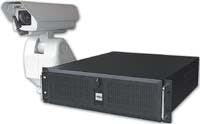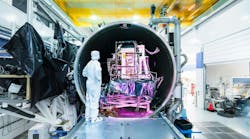By J.R. Wilson
NEWPORT, R.I. — LiveWave Inc. in Newport, R.I., is offering a real-time remote-control monitoring and surveillance system for use in any location — indoor or outdoor — including extreme environments, such as underwater.
The system offers sufficiently high resolution to be used with face-identification software to serve applications in reconnaissance, surveillance, and counter-terrorism.
The CC-100-SE video system supports several different cameras that users can control over a basic Internet Protocol (IP) connection — mobile wireless, or cable — for fluid pan, tilt, focus, white balance, iris, and zoom.
The system can be used with a variety of robotic cameras from such manufacturers as Hitachi, Panasonic, Pelco, Sensormatic, Sony, and Canon.
The system uses a unique JPEG compression and streaming video technology (JPEG push/pull for low latency online streaming at 320 by 240 pixels, as far away as 15 feet) to provide full-motion, high quality video regardless of the bandwidth connection.
Anchoring the system is a rackmount 3U Pentium III 1GHz server with 256MB of RAM.
"Our SE server/ encoder system provides the high-resolution full motion video needed for today's cutting edge image surveillance, scanning and analysis systems," says LiveWave chief executive officer Peter Mottur.
"In addition, our unique real-time Web-based remote control technology has virtually no latency, offering security managers the best possible camera control and monitoring solution available. By using our IP-based system, a single security manager could centrally control and manage numerous security camera systems located worldwide, all inexpensively connected via the Internet.
"For example, a security agent could monitor in real time the activity of one or more airline baggage areas," he continues. "If he notices suspicious activity, he could pan the crowded area and zoom in on the activity. At the same time, the image could be instantaneously transmitted to a security agency located anywhere in the country for centralized storage archiving and forensic analysis as needed. This agency could then check the image against their 'watch list' database and authorize appropriate action. Authorized field officers, agents and personnel could also view these live or on-demand images using standard wireless mobile devices."
"Where a typical closed circuit system is basically Point A to Point B, a hardwired system, ours is designed around network environments," he says. "By using the Internet, for example, anyone with proper authorization can check the cameras. It also is makes it platform independent, so you can place the cameras anywhere, even in multiple locations, including tying it into an existing legacy system of cameras. That also allows for a quicker deployment, especially where cost and time are critical, as they are now for most potential users.
"We're getting a lot of interest from the military, government agencies and private companies," he continues. "And we're in discussions with a couple of the top face recognition software companies, but it also can be used to pick up license plates or other identifying items and run the video through special forensics software."



